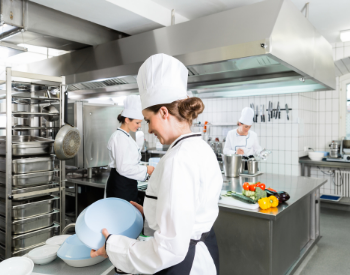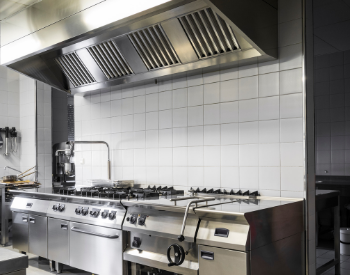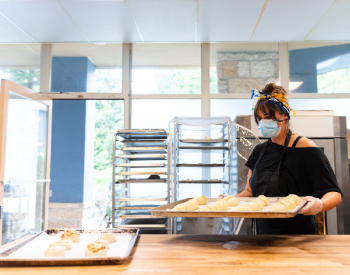At the beginning of the year, ghost kitchens were a popular, upcoming trend in the food and beverage industry. Now, due to the effects of the COVID-19 pandemic, restaurants across the country have closed their dining areas and focused on the surge in delivery and take out orders.
At the core of their business model, ghost kitchens are designed for food delivery and have adapted well to the rise in carry out orders. A virtual kitchen unsurprisingly might be the best investment for your restaurant as we continue to enforce social distancing measures throughout the country.
How Did Ghost Kitchens Become So Popular?

Ghost kitchens, also known as virtual kitchens or shared kitchen spaces, have become a popular concept amongst aspiring and established restaurateurs looking to make the most of their establishment and the fast-growing food delivery industry. Essentially, ghost kitchens are a shared kitchen location that restaurant owners can rent out to focus solely on preparing and sending out delivery orders.
Ghost kitchens remove the concept of open dining areas from food establishments and instead allow more room for kitchen and prep areas. Shared kitchen spaces optimize employee labor and can be used to test out several food concepts with little financial risks, which are huge selling points for those looking to invest in them.
How Ghost Kitchens Are Meeting The Demand For Take Out And Delivery
Due to the effects of the COVID-19 crisis and social distancing precautions, more customers are opting to stay inside and order delivery instead of going out to eat. This means that the demand for delivery and carry out orders have skyrocketed, and it’s important your restaurant updates its business model to meet the needs of your customers. While many restaurants might have not been equipped to handle the abrupt transition from dine-in orders to take out and delivery, virtual kitchens have always been prepared.
Shared kitchen spaces are designed without a dining room and feature organized prep stations that allow employees to prepare and streamline order assembly. By removing the need for a dining room, ghost kitchens are naturally built to only accommodate to-go orders, which comes in handy when meeting the growing number of delivery orders customers are placing. Virtual kitchens also emphasize the need to optimize order preparation and delivery and include a delivery pick-up area for couriers and shelving in between kitchen and pick-up areas to store orders in a contactless manner.
Why Ghost Kitchens Are Useful During The COVID-19 Crisis
In our current state of events, ghost kitchens might be a great tool for those looking to reap the benefits of their restaurant’s delivery services during the COVID-19 crisis. Virtual kitchens cater specifically to delivery and carry out customers and make the connection to third-party delivery platforms so much easier.
Shared kitchen spaces go hand-in-hand with delivery apps, as orders can be sent directly to the kitchen so employees can prepare meals quickly and efficiently. If your establishment is unable to partner with a third-party delivery app, then you can also optimize your ghost kitchen to receive orders from your restaurant’s online ordering services.
Maintaining Social Distancing In A Shared Kitchen Space

One of the most fundamental parts of a ghost kitchen is sharing the space with fellow employees. The need for social distancing, due to the spread of the coronavirus, was an unprecedented factor that virtual kitchens weren’t necessarily built to accommodate. However, virtual kitchens are extremely adaptable and can be optimized to follow social distancing precautions on a daily basis with some simple adjustments.
Take Precautions In Your Kitchen
Consider the social distancing standards that are in place in your state. When staffing your ghost kitchen, it is best to reduce the number of employees actively prepping foods in the kitchen at the same time. Keeping only the essential amount of employees in a common space helps lower the spread of viruses and bacteria. Virtual kitchens are built to take advantage of the extra space that removing a dining area leaves in your establishment, which allows employees to easily maintain distance between themselves.
Keep Orders Organized And Safe
Once orders are completed and ready for pick up, employees in a ghost kitchen usually leave them in a shelving area for couriers. In an effort to practice social distancing measures in your establishment and reduce confusion amongst delivery drivers, some changes should be made to this system.
- Provide gloves and sanitizing equipment for couriers to use before handling orders.
- Keep pick up and delivery orders completely separate from each other to reduce interactions between drivers and carry out customers.
- Prevent couriers from gathering in the delivery order area.
- Limit the number of delivery orders going out at the same time.
Sanitize Kitchen Equipment
As always, it is important to be mindful of sanitizing and cleaning your kitchen equipment throughout the day. Prepare your kitchen for incoming orders by having employees wipe down and wash their food stations and tools. At the end of your employee’s shift, they should carefully sanitize and wipe down their station so that other employees can work in a clean kitchen environment. Taking these kinds of extra steps is the best way to reduce the spread of germs to keep your employees and customers safe.
Reduce Overhead Costs
If you’re searching for a way to lower overhead costs or are interested in opening a restaurant of your own, ghost kitchens are an ideal solution to your financial needs. Due to the crumbling effects COVID-19 has had on the restaurant industry, cutting costs where possible is more important than ever. Ghost kitchens take away the additional costs of running a traditional dine-in restaurant with their cost-efficient structure.
No Need For A Brick And Mortar
By default, virtual kitchens eliminate the need for an open dining area. Shared kitchen spaces are designed to emphasize and optimize a commercial kitchen for full use. This means all kinds of costs that come with maintaining a brick and mortar dining space at your restaurant, such as furniture, tableware, additional staffing, and other overhead costs are eliminated. Renting a ghost kitchen costs substantially less than renting out a restaurant space. Most virtual kitchens even offer utility and rent bundles, as well as a fully equipped kitchen that might work well within your budget.
Speed Up Delivery
Virtual kitchens are perfect for streamlining delivery services at your restaurant. Most shared kitchen spaces are located in commercial hotspots which makes it easy for customers in the area to receive their orders quickly. You can even instruct your delivery drivers to focus on orders within a 5-7 mile radius of your shared establishment.
Ghost kitchens are optimized to take orders from third-party apps or your restaurant’s ordering services directly to the kitchen, where employees can prepare meals with little to no confusion. Virtual kitchen spaces that house several food concepts in one area are great for providing customers with plenty of options. Housing several restaurants in the same ghost kitchen means that drivers don’t have to go to various locations and overall delivery time is reduced.
Why Ghost Kitchens Fit Your Delivery Model

Although ghost kitchens preceded the current social distancing measures and the effects of the COVID-19 crisis, they are a fast-growing trend that is here to stay. Now more than ever, emphasizing your restaurant’s delivery services is needed to keep your business afloat. Virtual kitchens can help optimize your restaurant for an efficient and smooth transition to delivery-only orders.
Shared kitchen spaces offer a multitude of benefits that make it easy to cut down on unnecessary costs. The removal of dining areas in restaurants is a topic many in the food and beverage industry are already considering, and your business should be one step ahead. The limited number of employees needed to run a ghost kitchen along with the additional space makes shared kitchens completely adaptable to social distancing guidelines.
By investing in a ghost kitchen, much of the work needed to convert a traditional restaurant to a food delivery service has already been done. Looking towards the future of the restaurant industry, the ghost kitchen model is definitely here to stay and worth considering as you begin to take the steps towards adapting to a surge in delivery orders.








